SuperPro Designer®, User-Oriented Software Used for Analyzing the Techno-Economic Feasibility of Electrical Energy Generation from Sugarcane Vinasse in Colombia
Abstract
1. Introduction
2. Material and Methods
2.1. Physicochemical Characterization of Inoculum and Substrates
2.2. Biomethane Potential (BMP) Analysis
2.3. Statistical Analysis
2.4. Model Generation for Biogas Production: Simulation Description
2.5. Process Description
2.6. Economic Analysis
2.7. Sensibility Analysis
2.8. Profitability Analysis
3. Results and Discussion
3.1. Vinasse Characterization and BMP Analysis
3.2. TEA Evaluation and Sensitivity Analysis
3.3. Economic Assessment
4. Conclusions
Author Contributions
Funding
Conflicts of Interest
References
- Bausea, K.; Radimerskya, A.; Iwanickia, M.; Albersa, A. Feasibility Studies in the Product Development Process. Procedia CIRP 2014, 21, 473–478. [Google Scholar] [CrossRef]
- Tochampa, W.; Sirisansaneeyakul, A. A model of Xylitol Production by The Yeast Candida Mogii. Bioprocess Biosyst. Eng. 2005, 28, 175–183. [Google Scholar] [CrossRef] [PubMed]
- Viswanathan, M.B.; Raman, D.R.; Rosentrater, K.A.; Shanks, B.H. A Technoeconomic Platform for Early-Stage Process Design and Cost Estimation of Joint Fermentative‒Catalytic Bioprocessing. Processes 2020, 8, 229. [Google Scholar] [CrossRef]
- Alnur Auli, N.; Sakinah, M.; Mustafa Al Bakri, A.M.; Kamarudin, H.; Norazian, M.N. Simulation Of Xylitol Production: A Review. Aust. J. Basic Appl. Sci. 2013, 7, 366–372. [Google Scholar]
- Farid, S.S.; Washbrook, A. Modelling Biopharmaceutical Manufacture: Design and Implementation of SimBiopharma. Comput. Chem. Eng. 2007, 31, 1141–1158. [Google Scholar] [CrossRef]
- Verhoef, A.; Degreve, J. Simulation of a Hybrid Pervaporation–Distillation Process. Comput. Chem. Eng. 2008, 32, 1135–1146. [Google Scholar] [CrossRef]
- Pandu, G.; Kariwala, V. Plantwide Control: Recent Developments and Applications; Wiley: Hoboken, NJ, USA, 2012; pp. 1–494. [Google Scholar]
- Athimulam, A.; Kumaresan, S. Modelling and Optimization of Eurycoma Longifolia Water Extract Production. Food Bioprod. Process. 2006, 84, 139–149. [Google Scholar] [CrossRef]
- Ernst, S.; Garro, O.A. Process Simulation for Recombinant Protein Production: Cost Estimation and Sensitivity Analysis for Heparinase I Expressed in Escherichia coli. Biotechnol. Bioeng. 1997, 53, 575–582. [Google Scholar] [CrossRef]
- Humphrey, W. Systems of Systems: Scaling Up the Development Process (CMU/SEI-2006-TR-017) 2006. Retrieved June 10, 2020, from the Software Engineering Institute, Carnegie Mellon University Website. Available online: http://resources.sei.cmu.edu/library/asset-view.cfm?AssetID=8135 (accessed on 10 June 2020).
- Thien, Y.N. BioMASS v2.0: A New Tool For Bioprocess Simulation. Master’s Thesis, Biosystems Engineering, Clemson University, Clemson, SC, USA, 2011; pp. 1–19. [Google Scholar]
- Qureshi, N.; Saha, B.C. An Economic Evaluation of Biological Conversion of Wheat Straw to Butanol: A biofuel. Energy Convers. Manag. 2013, 65, 456–462. [Google Scholar] [CrossRef]
- Biwer, A.; Heinzel, E. Environmental assessment in early process development. J. Chem. Technol. Biotechnol. 2004, 79, 597–609. [Google Scholar] [CrossRef]
- Rouf, S.A.; Douglas, P.L.; Young, M.M. Computer Simulation for Large Scale Bioprocess Design. Biochem. Eng. J. 2001, 8, 229–234. [Google Scholar] [CrossRef]
- Samer, M. A software Program for Planning and Designing Biogas Plants. Trans. ASABE 2010, 53, 1277–1285. [Google Scholar] [CrossRef]
- De Clercq, D.; Jalota, D.; Shang, R.; Ni, K.; Zhang, Z.; Khan, A.; Wen, Z.; Caicedo, L.; Yuan, K. Machine learning powered software for accurate prediction of biogas production: A case study on industrial-scale Chinese production data. J. Clean. Prod. 2019, 218, 390–399. [Google Scholar] [CrossRef]
- Mabalane, P.N.; Oboirien, B.O.; Sadiku, E.R.; Masukume, M. A Techno-economic Analysis of Anaerobic Digestion and Gasifcation Hybrid System: Energy Recovery from Municipal Solid Waste in South Africa. Waste Biomass Valorization 2020. [Google Scholar] [CrossRef]
- Scotto di Perta, E.; Cervelli, E.; Pironti di Campagna, M.; Pindozzi, S. From biogas to biomethane: Techno-economic analysis of an anaerobic digestion power plant in a cattle/buffalo farm in central Italy. J. Agric. Eng. 2019, 50, 127–133. [Google Scholar] [CrossRef]
- Albrecht, F.G.; König, D.H.; Baucks, N.; Dietrich, R.U. A standardized methodology for the techno-economic evaluation of alternative fuels—A case study. Fuel 2017, 194, 511–526. [Google Scholar] [CrossRef]
- Akbulut, A. Techno-economic analysis of electricity and heat generation from farm-scale biogas plant: Çiçekdağı case study. Energy 2012, 44, 381–390. [Google Scholar] [CrossRef]
- Sanscartier, D.; MacLean, H.L.; Saville, B. Electricity Production from Anaerobic Digestion of Household Organic Waste in Ontario: Techno-Economic and GHG Emission Analyses. Environ. Sci. Technol. 2012, 46, 1233–1242. [Google Scholar] [CrossRef]
- Nogueira, C.E.C.; de Souza, S.N.M.; Micuanski, V.C.; Azevedo, R.L. Exploring possibilities of energy insertion from vinasse biogas in the energy matrix of Paraná State, Brazil. Renew. Sustain. Energy Rev. 2015, 48, 300–305. [Google Scholar] [CrossRef]
- Pazuch, F.A.; Nogueira, C.E.C.; Souza, S.N.M.; Micuanski, V.C.; Friedrich, L.; Lenz, A.M. Economic evaluation of the replacement of sugar cane bagasse by vinasse, as a source of energy in a power plant in the state of Paraná, Brazil. Renew. Sustain. Energy Rev. 2017, 76, 34–42. [Google Scholar] [CrossRef]
- Fuess, L.T.; Zaiat, M. Economics of anaerobic digestion for processing sugarcane vinasse: Applying sensitivity analysis to increase process profitability in diversified biogas applications. Process Saf. Environ. Prot. Biowaste Energy Recovery Environ. Remediat. 2018, 115, 27–37. [Google Scholar] [CrossRef]
- Asocaña, Fondo de Estabilización de Precios del Azúcar-FEPA. Balance Azucarero Colombiano Asocaña 2000–2019. Available online: https://www.asocana.org/modules/documentos/5528.aspx (accessed on 20 March 2020).
- Moraes, B.S.; Zaiat, M.; Bonomi, A. Anaerobic digestion of vinasse from sugarcane ethanol production in Brazil: Challenges and perspectives. Renew. Sustain. Energy Rev. 2015, 44, 888–903. [Google Scholar] [CrossRef]
- Rocha, M.H.; Lora, E.E.S.; Venturini, O.J. Life cycle analysis of different alternatives for the treatment and disposal of ethanol vinasse. Proc. Int. Soc. Sugar Cane Technol. 2007, 26, 1075–1084. [Google Scholar]
- Christofoletti, C.A.; Escher, J.P.; Correia, J.E.; Marinho, J.F.U.; Fontanetti, C.S. Sugarcane vinasse: Environmental implications of its use. Waste Manag. 2013, 33, 2752–2761. [Google Scholar] [CrossRef]
- Meyer, J.; Rein, P.; Turner, P.; Mathias, K.; Mc Gregor, C. Good Management Practices Manual for the Cane Sugar Industry (Final); PGBI Sugar and Bio Energy, PGBI House: Johannesburg, South Africa, 2011; pp. 1–696. [Google Scholar]
- Kowalska-wentel, M. Effect of enzymatic pretreatment on anaerobic co-digestion of sugar beet pulp silage and vinasse. Bioresour. Technol. 2015, 180, 274–280. [Google Scholar]
- Santos, R.F.; Borsoi, A.; Secco, D.; Melegari de Souza, S.N.; Constanzi, R.N. Brazil’s potential for generating electricity from biogas from stillage. In Proceedings of the World Renewable Energy Congress, Linköping, Sweden, 8–13 May 2011; pp. 425–432. [Google Scholar]
- Wilkie, A.C.; Riedesel, K.J.; Owens, J.M. Stillage characterization and anaerobic treatment of ethanol stillage from conventional and cellulosic feedstocks. Biomass Bioenergy 2000, 19, 63–102. [Google Scholar] [CrossRef]
- Ortegón, G.P.; Arboleda, F.M.; Candela, L.; Tamoh, K.; Valdes-Abellan, J. Vinasse Application to Sugar Cane Fields. Effect on the Unsaturated Zone and Groundwater at Valle Del Cauca (Colombia). Sci. Total Environ. 2016, 539, 410–419. [Google Scholar]
- Sowmeyan, R.; Swaminathan, G. Effluent treatment process in molasses-based distillery industries: A review. J. Hazard. Mater. 2008, 152, 453–462. [Google Scholar] [CrossRef]
- Parsaee, M.; Kiani Deh Kiani, M.; Karimi, K. A review of biogas production from sugarcane vinasse. Biomass Bioenergy 2019, 122, 117–125. [Google Scholar] [CrossRef]
- Đurđević, D.; Hulenić, I. Anaerobic Digestate Treatment Selection Model for Biogas Plant Costs and Emissions Reduction. Processes 2020, 8, 142. [Google Scholar] [CrossRef]
- Preciogas by Selectra. Price of kWh of Natural Gas in 2019. Available online: https://preciogas.com/faq/factor-conversion-gas-natural-kwh (accessed on 27 June 2020).
- Kayhanian, M.; Tchobanoglous, G. Computation of C/N ratios for various organic fractions. Biocycle 1992, 33, 58–60. [Google Scholar]
- Weinrich, S.; Schäfer, F.; Bochmann, G.; Liebetrau, J. Value of Batch Tests for Biogas Potential Analysis, Method Comparison and Challenges of Substrate and Efficiency Evaluation of Biogas Plants; Murphy, J.D., Ed.; IEA Bioenergy Task 37; IEA Bioenergy: Cork, Ireland, 2018; p. 10. ISBN 978-1-910154-49-6. [Google Scholar]
- Justesen, C.G.; Astals, S.; Mortensen, J.R.; Thorsen, R.; Koch, K.; Weinrich, S.; Triolo, J.M.; Hafner, S.D. Development and Validation of a Low-Cost Gas Density Method for Measuring Biochemical Methane Potential (BMP). Water 2019, 11, 2431. [Google Scholar] [CrossRef]
- Hafner, S.D.; Koch, K.; Carrere, H.; Astals, S.; Weinrich, S.; Renniut, C. Software for biogas research: Tools for measure and prediction of methane production. SoftwareX 2018, 7, 205–210. [Google Scholar] [CrossRef]
- Filer, J.; Ding, H.H.; Chang, S. Biochemical methane potential (BMP) Assay Method for Anaeronic Digestion Research. Water 2019, 11, 921. [Google Scholar] [CrossRef]
- Holliger, C.; Fruteau de Laclos, H.; Hack, G. Methane Production of Full-Scale Anaerobic Digestion Plants Calculated from Substrate’s Biomethane Potentials Compares Well with the One Measured On-Site. Front. Energy Res. 2017, 5, 12. [Google Scholar] [CrossRef]
- Roubík, H.; Mazancová, J.; Rydval, J.; Kvasnicka, R. Uncovering the dynamic complexity of the development of small-scale biogas technology through casual loops. Renew. Energy 2020, 149, 235–243. [Google Scholar] [CrossRef]
- Zamalloa, C.; Vulsteke, E.; Albrecht, J.; Verstraete, W. The techno-economic potential of renewable energy through the anaerobic digestion of microalgae. Bioresour. Technol. 2011, 102, 1149–1158. [Google Scholar] [CrossRef]
- Dave, A.; Huang, Y.; Rezvani, S.; Mcilveen-Wright, D.; Novaes, M.; Hewitt, N. Techno-economic assessment of biofuel development by anaerobic digestion of European marine cold-water seaweeds. Bioresour. Technol. 2013, 135, 120–127. [Google Scholar] [CrossRef]
- Budiyono; Syaichurrozi, I.; Sumardiono, S. Effect of Total Solid Content to Biogas Production Rate from Vinasse (RESEARCH NOTE). Int. J. Eng. 2014, 27, 177–184. [Google Scholar]
- Fuess, L.T.; Garcia, M.L. Anaerobic biodigestion for enhanced bioenergy generation in ethanol biorefineries: Understanding the potentials of vinasse as a biofuel. In Bioenergy Systems for the Future: Prospects for Biofuels and Biohydrogen; Woodhead Publishing: Sawston, Cambridge, UK, 2017; pp. 149–183. [Google Scholar]
- Siddique, M.N.I.; Sakinah, M.; Zularisam, A.W. Influence of flow rate variation on bio-energy generation during anaerobic co-digestion. J. Ind. Eng. Chem. 2015, 27, 44–49. [Google Scholar] [CrossRef][Green Version]
- Caposciutii, G.; Baccioli, A.; Ferrari, L.; Desideri, U. Biogas from anerobic digestion: Power generation or biomethane production? Energies 2020, 13, 743. [Google Scholar] [CrossRef]
- Bernal, A.P.; dos Santos, I.F.S.; Moni Silva, A.P.; Barros, R.M.; Ribeiro, E.M. Vinasse biogas for energy generation in Brazil: An assessment of economic feasibility, energy potential and avoided CO2 emissions. J. Clean. Prod. 2017, 151, 260–271. [Google Scholar] [CrossRef]
- Willeghems, G.; Buysse, J. Changing old habits: The case of feeding patterns in anaerobic digesters. Renew. Energy 2016, 92, 212–221. [Google Scholar] [CrossRef]
- Salomon, K.R.; Lora, E.E.S.; Rocha, M.H.; del Olmo, O.A. Cost Calculations for 751 biogas from vinasse biodigestion and its energy utilization. Sugar Ind. 2011, 136, 217–223. [Google Scholar] [CrossRef]
- Rajendran, K. Industrial Bioprocess Developments for Biogas and Ethanol Production. Ph.D. Thesis, University of Borås, Borås, Sweden, 2015. Available online: http://urn.kb.se/resolve?urn=urn:nbn:se:hb:diva-668 (accessed on 15 April 2020).
- Nadaleti, W.C.; Lourenco, V.A.; Filho, P.B.; Santos, G.B.; Przybyla, G. National potential production of methane and electrical energy from sugarcane vinasse in Brazil: A thermo-economic analysis. J. Environ. Chem. Eng. 2019, 8, 103422. [Google Scholar] [CrossRef]
- Junqueira, T.L.; Moraes, B.; Gouveia, V.L.R.; Chagas, M.F.; Morais, E.R.; Watanabe, M.D.B.; Zaiat, M.; Bonomi, A. Use of VSB to plan research programs and public policies. In Virtual Biorefinery: An Optimization Strategy for Renewable Carbon Valorization; Bonomi, A., Cavalett, O., Cunha, M.P., Lima, M.A.P., Eds.; Springer: Berlin, Germany, 2016; pp. 257–282. [Google Scholar]
- Lorenzo-Llanes, J.; Pagés-Díaz, J.; Kalogirou, E.; Contino, F. Development and application in Aspen Plus of a process simulation model for the anaerobic digestion of vinasses in UASB reactors: Hydrodynamics and biochemical reactions. J. Environ. Chem. Eng. 2019, 8, 103540. [Google Scholar] [CrossRef]
- Monlau, F.; Sambusiti, C.; Ficara, E.; Aboulkas, A.; Barakat, A.; Carrère, H. New opportunities for agricultural digestate valorization: Current situation and perspectives. Energy Environ. Sci. 2015, 8, 2600–2621. [Google Scholar] [CrossRef]
- Fuchs, W.; Drosg, B. Assessment of the state of the art of technologies for the processing of digestate residue from anaerobic digesters. Water Sci. Technol. 2013, 67, 1984–1993. [Google Scholar] [CrossRef] [PubMed]
- Moraes, B.S.; Junqueira, T.L.; Pavanello, L.G.; Cavalett, O.; Mantelatto, P.E.; Bonomi, A.; Zaiat, M. Anaerobic digestion of vinasse from sugarcane biorefineries in Brazil from energy, environment, and economic perspectives: Profit or expense? Appl. Energy 2014, 113, 825–835. [Google Scholar] [CrossRef]

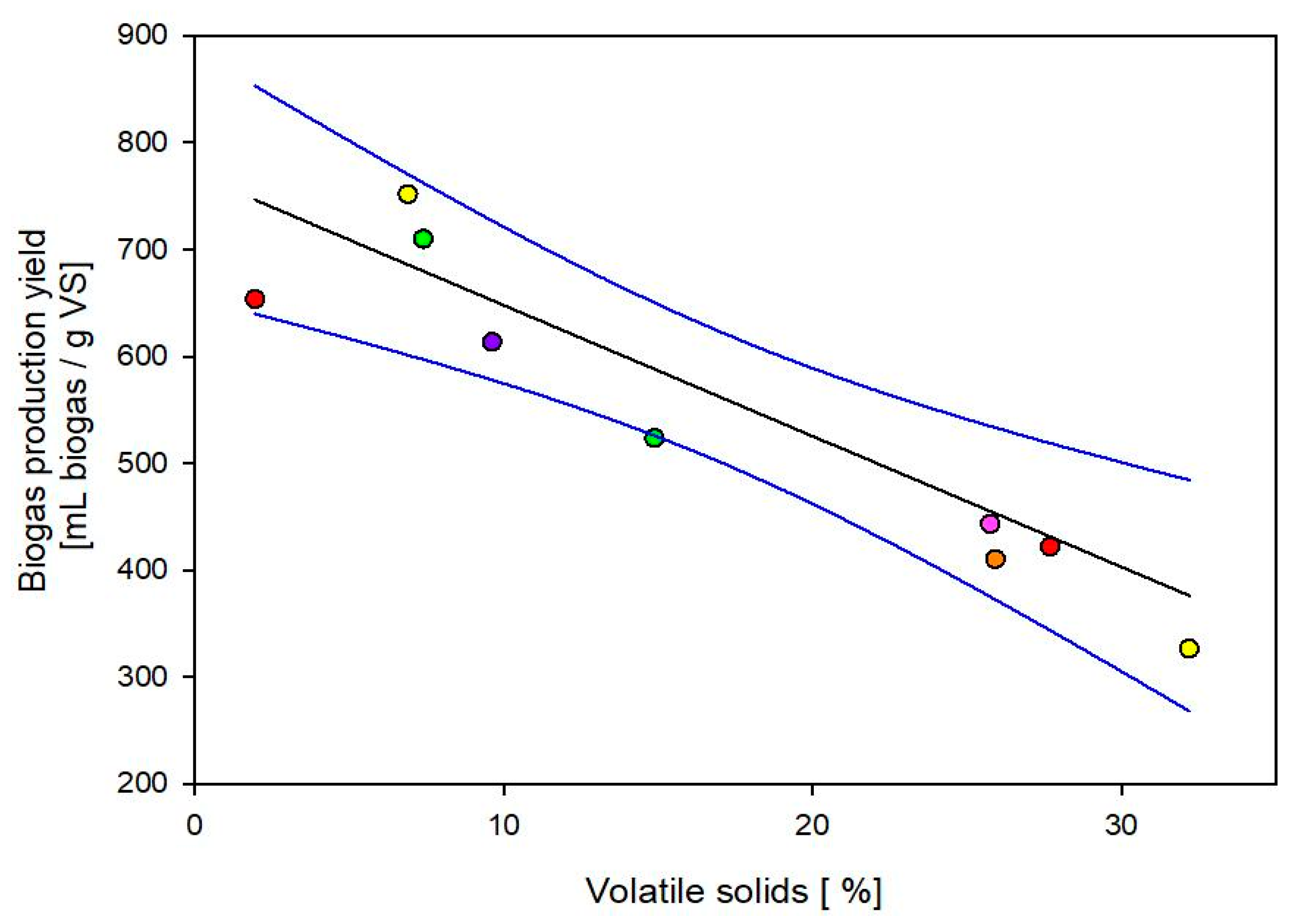
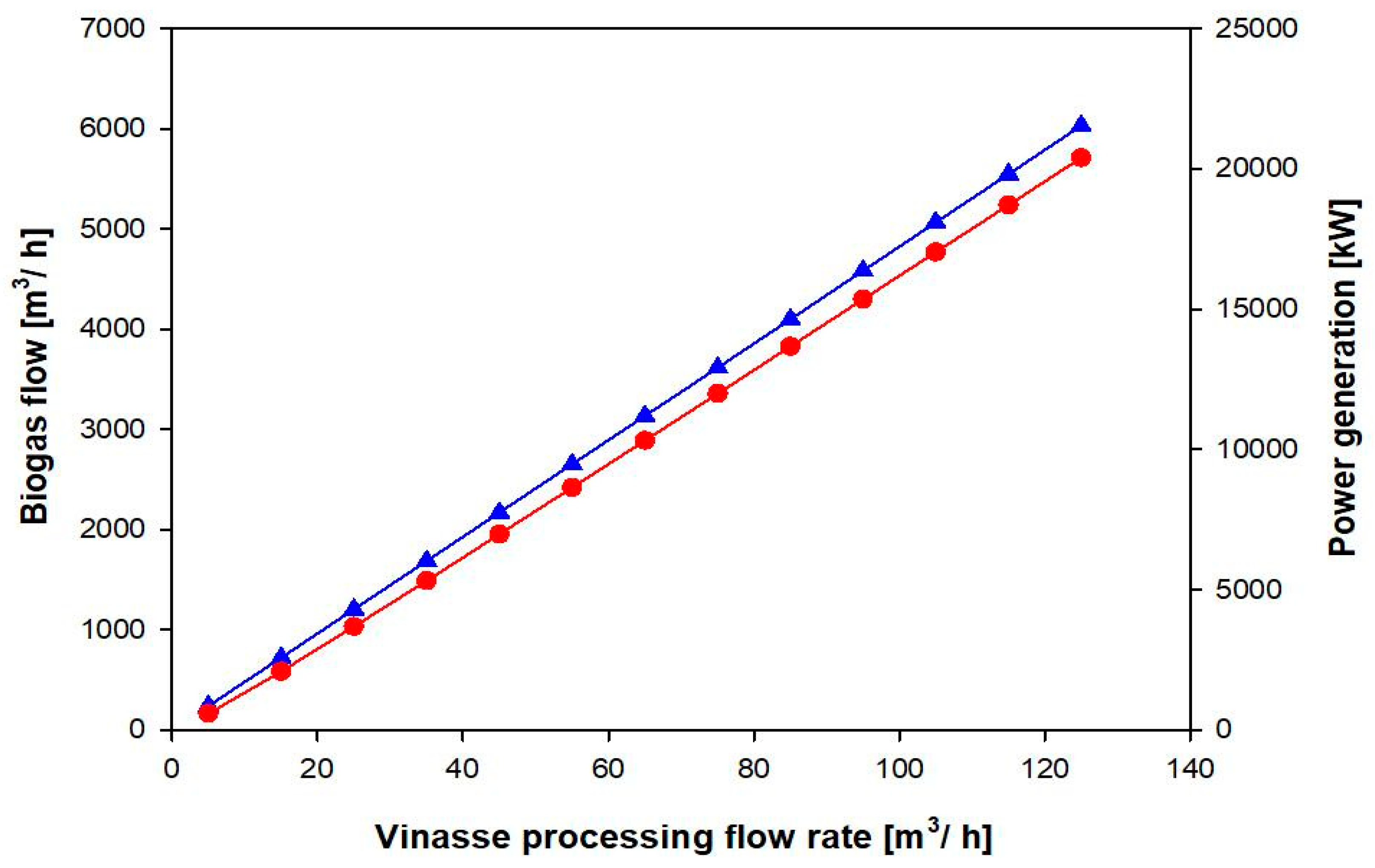
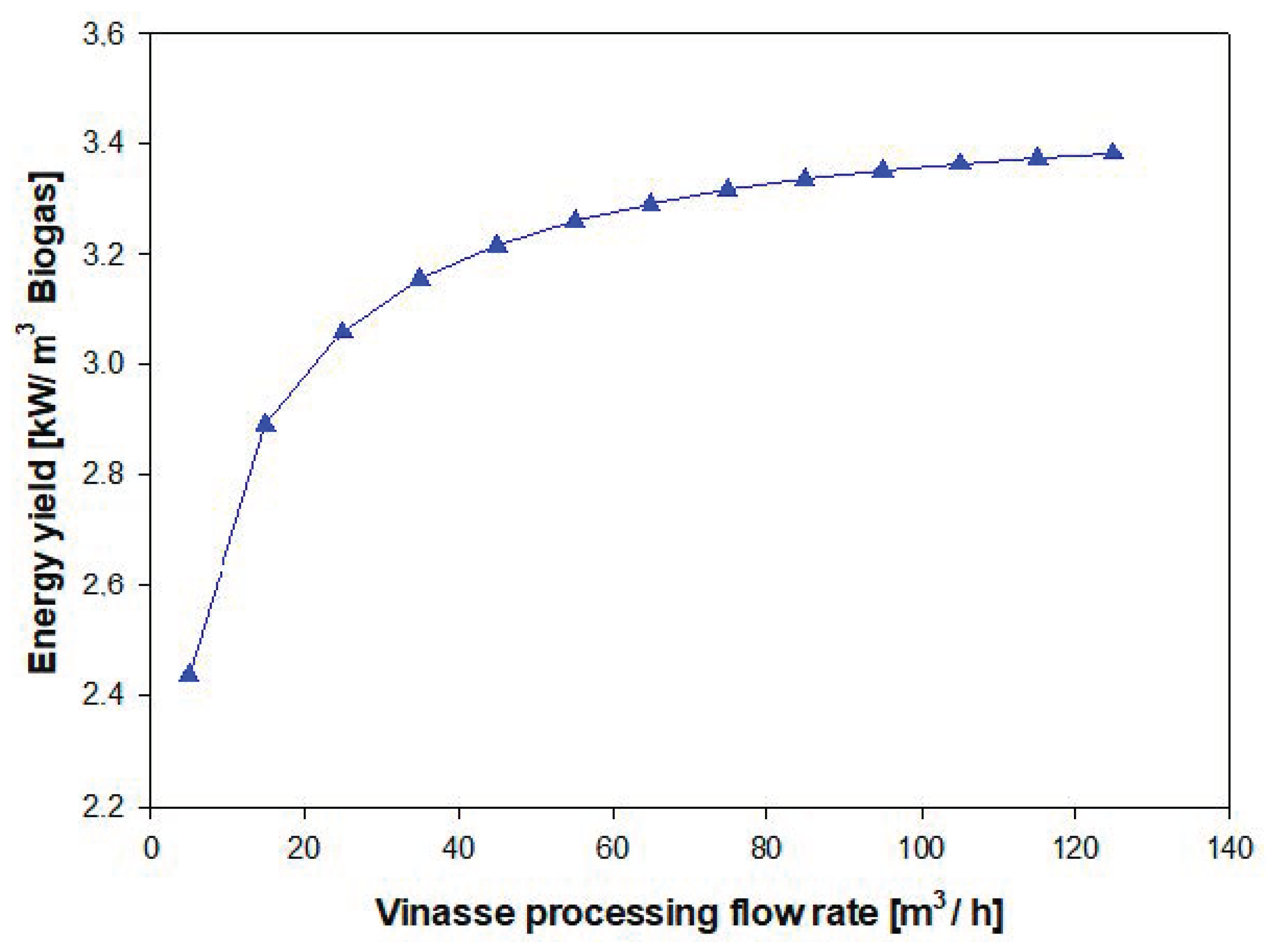
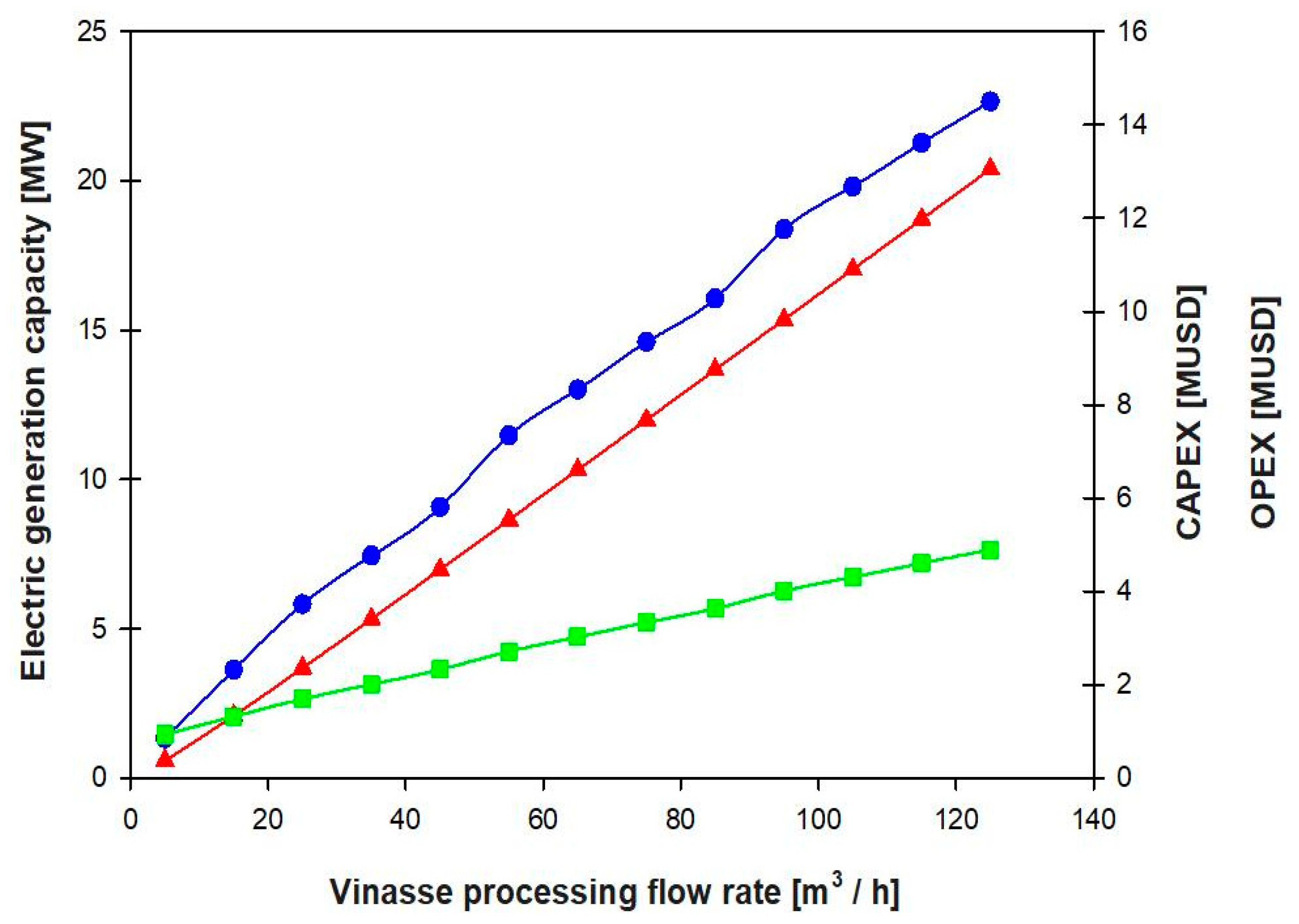
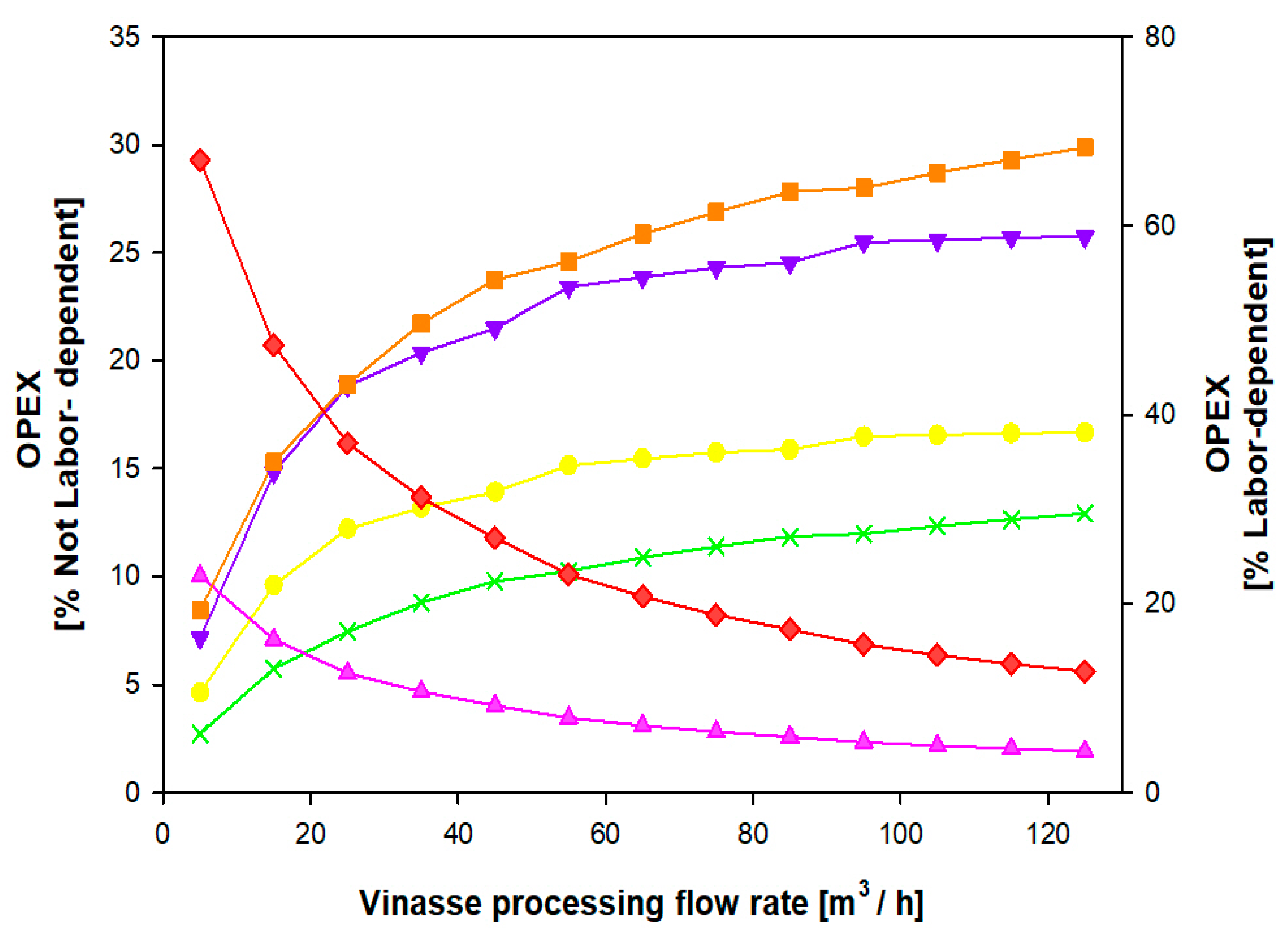
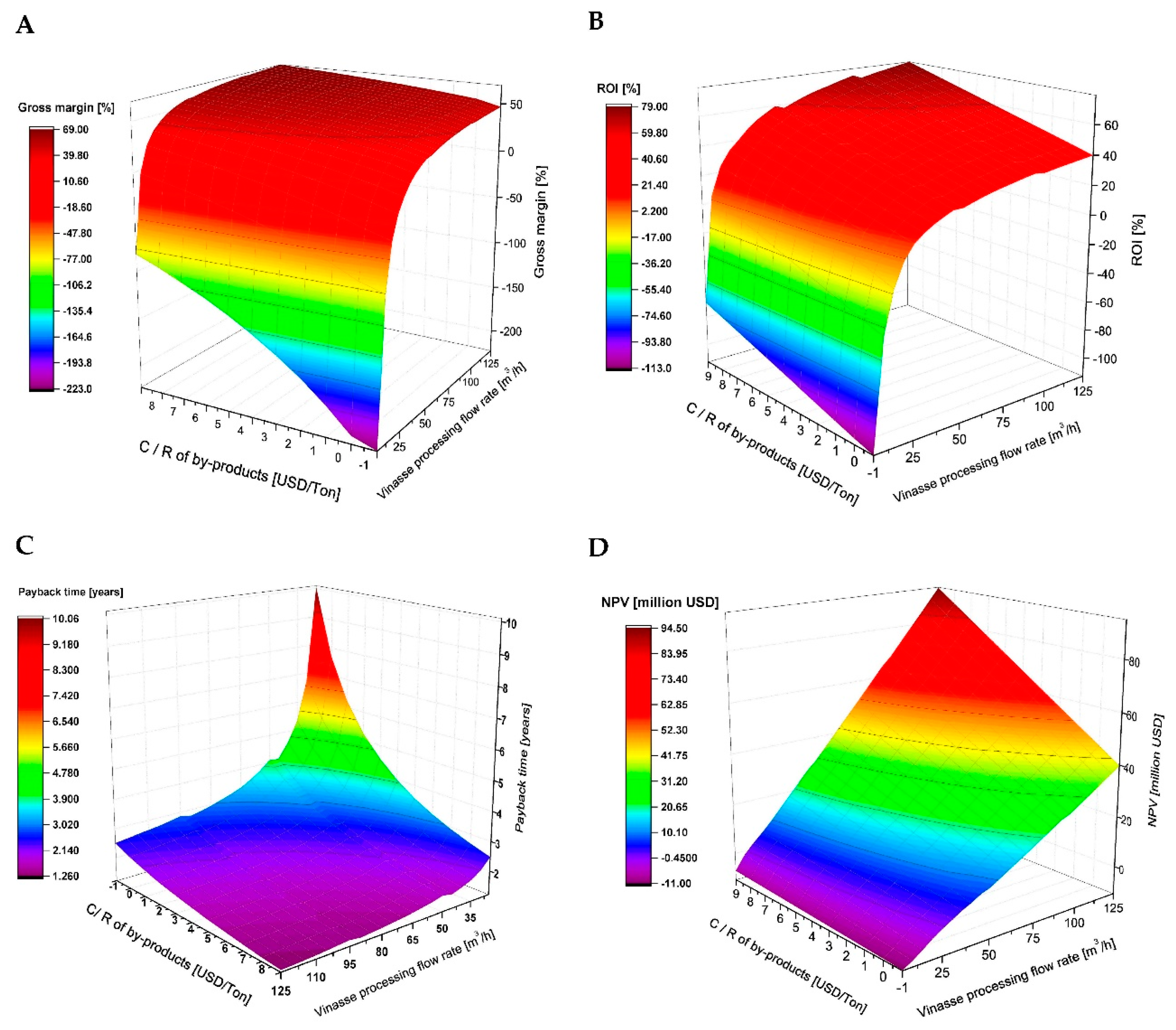
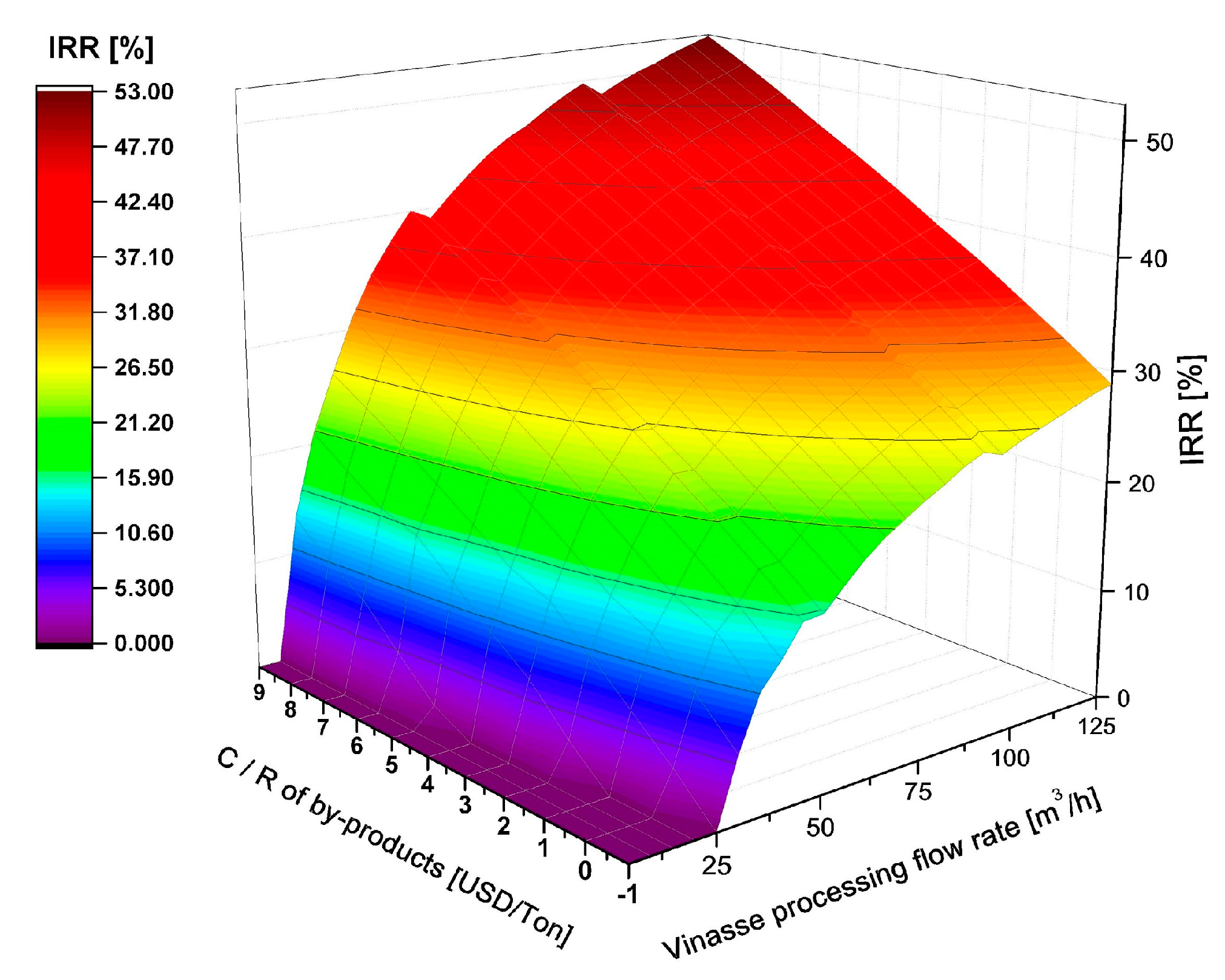
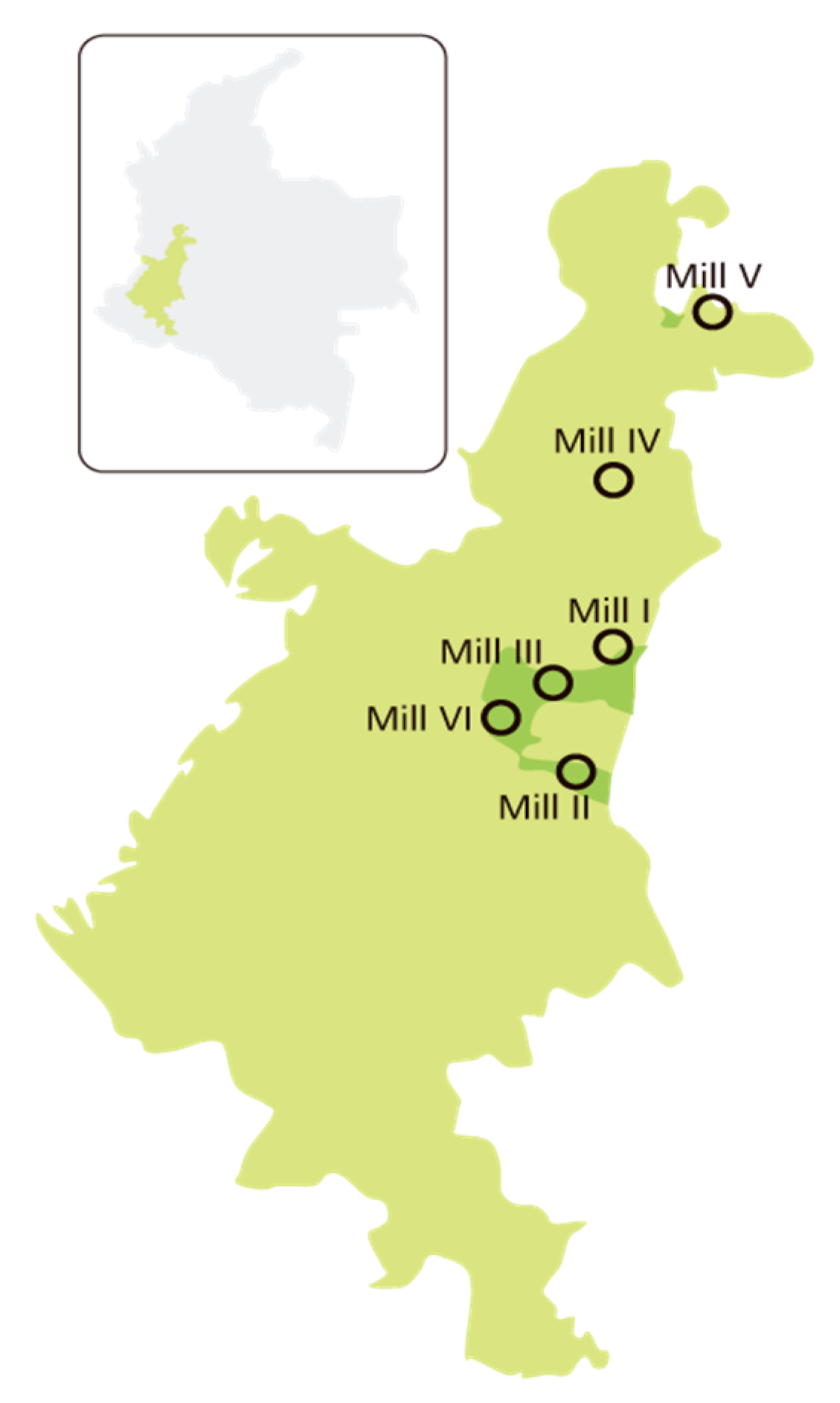
| Process Step | Parameter | Value |
|---|---|---|
| Compression | Efficiency (%) | 60 |
| Pressure change (bar) | 59 | |
| Exit temperature (°C) | 37 | |
| Burning | Air feeding (%) | 46.6 |
| Expansion | Outlet pressure (bar) | 1 |
| Time Parameters | Value |
|---|---|
| Construction period (months) | 30 |
| Startup period (months) | 4 |
| Project life (years) | 15 |
| Inflation rate (%) | 4 |
| Interest (%) | 3 |
| Labor-dependent cost | Value |
| Operators (USD/h) | 6.9 |
| Generator specialized technician (USD/h) | 69 |
| Workforce on the plant | Value |
| Storage tank (h) | 1 |
| Anaerobic digester (h) | 0.5 |
| Electric generator (h) | 0.05 |
| Item Code | Equipment | Low-End Capacity | High-End Capacity | Base Capacity (Qo) | Base Cost (Co) (USD) |
|---|---|---|---|---|---|
| P0/MX | Mixer | Set by the user (local supply) | 8000 | ||
| P1/ST | Storage tank | 5 m3 | 61,200 m3 | 764 m3 | 61.2 |
| P2/AD | Anaerobic digester | 10 m3 | 971,150 m3 | 4500 m3 | 971,150 |
| P3/SP | Flow splitting | Set by the user (local supply) | 4000 | ||
| P4/GC | Gas compressor | SuperPro Designer® built-in cost model | |||
| P5/GB | Gas burner | SuperPro Designer® built-in cost model | |||
| P6/GE | Gas expansion | ||||
| P7/CD | Centrifugal decanter | 100 L/h | 9000 m3/h | 24,230 L/h | 27,850 |
| Sample- Mill | C (%) | N (%) | C/N Ratio | TS (%) | VS (%) | Humidity (%) | pH |
|---|---|---|---|---|---|---|---|
| Concentrated vinasse—I | 13.3 | 0.73 | 18.12 | 76.36 ± 9 × 10−5 | 32.2 ± 0.001 | 42.17 ± 0.001 | 5.04 ± 0.005 |
| Diluted vinasse—I | 3.23 | 0.39 | 8.24 | 72.75 ± 6 × 10−5 | 7.39 ± 5 × 10−5 | 10.16 ± 2.2 × 10−5 | 5.03 ± 0.02 |
| Concentrated vinasse—II | 14.9 | 1.57 | 9.49 | 74.1 ± 0.001 | 25.93 ± 6 × 10−4 | 34.99 ± 0.001 | 4.29 ± 0.000 |
| Concentrated vinasse—III | 13.4 | 1 | 13.4 | 77.96 ± 9 × 10−5 | 25.76 ± 4 × 10−5 | 33.04 ± 1 × 10−4 | 4.26 ± 0.005 |
| Diluted vinasse—III | 5.13 | 0.66 | 7.8 | 66.51 ± 8 × 10−4 | 13.78 ± 1 × 10−4 | 20.72 ± 5.7 × 10−6 | 4.12 ± 0.005 |
| Concentrated vinasse—IV | 15.5 | 1.27 | 12.21 | 73.23 ± 4 × 10−4 | 27.7 ± 0.02 | 37.83 ± 0.03 | 4.45 ± 0.001 |
| Diluted vinasse—IV | 1.64 | 0.36 | 4.61 | 65.55 ± 0.002 | 1.95 ± 1 × 10−5 | 2.98 ± 9.7 × 10−5 | 4.4 ± 0.002 |
| Concentrated vinasse—V | 14.3 | 0.83 | 17.17 | 71.9 ± 0.003 | 14.88 ± 4 × 10−4 | 20.7 ± 4 × 10−4 | 4.73 ± 0.000 |
| Diluted vinasse—V | 6.86 | 0.82 | 8.35 | 64.46 ± 8 × 10−5 | 9.63 ± 8.6 × 10−5 | 14.94 ± 7 × 10−5 | 4.5 ± 0.001 |
| Concentrated vinasse—VI | 17.4 | 1.28 | 13.6 | 68.38 ± 0.001 | 6.9 ± 2 × 10−4 | 10.1 ± 4 × 10−5 | 4.01 ± 0.005 |
© 2020 by the authors. Licensee MDPI, Basel, Switzerland. This article is an open access article distributed under the terms and conditions of the Creative Commons Attribution (CC BY) license (http://creativecommons.org/licenses/by/4.0/).
Share and Cite
Canizales, L.; Rojas, F.; Pizarro, C.A.; Caicedo-Ortega, N.H.; Villegas-Torres, M.F. SuperPro Designer®, User-Oriented Software Used for Analyzing the Techno-Economic Feasibility of Electrical Energy Generation from Sugarcane Vinasse in Colombia. Processes 2020, 8, 1180. https://doi.org/10.3390/pr8091180
Canizales L, Rojas F, Pizarro CA, Caicedo-Ortega NH, Villegas-Torres MF. SuperPro Designer®, User-Oriented Software Used for Analyzing the Techno-Economic Feasibility of Electrical Energy Generation from Sugarcane Vinasse in Colombia. Processes. 2020; 8(9):1180. https://doi.org/10.3390/pr8091180
Chicago/Turabian StyleCanizales, Licelly, Fredy Rojas, Carlos A. Pizarro, Nelson. H. Caicedo-Ortega, and M. F. Villegas-Torres. 2020. "SuperPro Designer®, User-Oriented Software Used for Analyzing the Techno-Economic Feasibility of Electrical Energy Generation from Sugarcane Vinasse in Colombia" Processes 8, no. 9: 1180. https://doi.org/10.3390/pr8091180
APA StyleCanizales, L., Rojas, F., Pizarro, C. A., Caicedo-Ortega, N. H., & Villegas-Torres, M. F. (2020). SuperPro Designer®, User-Oriented Software Used for Analyzing the Techno-Economic Feasibility of Electrical Energy Generation from Sugarcane Vinasse in Colombia. Processes, 8(9), 1180. https://doi.org/10.3390/pr8091180





